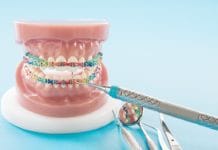1. Burning mouth syndrome is often described as a burning sensation. However, other symptoms associated with burning mouth syndrome include itching, numbness, taste alterations, and xerostomia.
The most common manifestation of burning mouth syndrome is reported as a “burning” sensation. However, other manifestations include itching sensation, numbness, taste alterations (complete loss of taste of bitter, acidic, and spicy foods), and xerostomia.
Coculescu, E.C., Radu, A., Coculescu, B.I. Burning Mouth Syndrome: A Review on Diagnosis and Treatment. Journal of Medicine and Life. 2014; 7(4): 512-515. https://www.ncbi.nlm.nih.gov/pmc/articles/PMC4316128/
2. Which is the most common area(s) affected by burning mouth syndrome?
Symptoms are almost always located in multiple sites of the oral mucosa, with the anterior two-thirds of the tongue, anterior hard palate, and lower lip mucosa being the most affected areas.
Coculescu, E.C., Radu, A., Coculescu, B.I. Burning Mouth Syndrome: A Review on Diagnosis and Treatment. Journal of Medicine and Life. 2014; 7(4): 512-515. https://www.ncbi.nlm.nih.gov/pmc/articles/PMC4316128/
3. The intensity and duration of burning mouth syndrome symptoms do not vary from patient to patient.
The intensity and duration of burning mouth syndrome symptoms can vary from patient to patient. Because of this, it has been proposed that classifying burning mouth syndrome into three clinical subtypes should be recognized.
Those three clinical subtypes are:
- Type 1: Associated with systemic diseases and nutritional deficiencies
- Type 2: Associated with psychological disorders
- Type 3: Associated with allergic reactions or local factors
Coculescu, E.C., Radu, A., Coculescu, B.I. Burning Mouth Syndrome: A Review on Diagnosis and Treatment. Journal of Medicine and Life. 2014; 7(4): 512-515. https://www.ncbi.nlm.nih.gov/pmc/articles/PMC4316128/
4. H. pylori infection is a comorbidity for burning mouth syndrome. Irritable bowel syndrome has no association with burning mouth syndrome.
There are multiple medical comorbidities associated with burning mouth syndrome:
- Psychiatric: Anxiety, depression, panic attacks, PTSD, and OCD
- Pain: Lower back pain, neck and shoulder pain, migraines/headaches, TMD, and myofascial pain
- Extraoral dysesthesia: Dry eyes, skin, and genitalia
- Functional somatic syndromes: Irritable bowel syndrome, H. pylori infection, fibromyalgia, and chronic fatigue syndrome
- Other: Stressors, tinnitus, palpitation
Lan Tan, H., Renton, T. Burning Mouth Syndrome: An Update. Cephalalgia Reports. 2020; 3: 1-18. https://journals.sagepub.com/doi/pdf/10.1177/2515816320970143
5. Oral parafunctional habits that may cause an oral burning sensation include which of the following?
Multiple local factors can cause an oral burning sensation. They are categorized into five categories:
A. Oral mucosa disease/lesions/conditions
- Fungal infections: Candidiasis
- Inflammatory conditions: Lichen planus, pemphigus, geographic tongue
B. Trauma
- Mechanical: Ill-fitting dentures, sharp edges of teeth and/or restorations
- Chemical: Toothpastes, mouthwashes, medications, vitamin C (citrus), acidic drinks, menthol lozenges, acrylic resins, eugenol
- Thermal: Hot and spicy food or drinks
C. Oral parafunctional habits
- Tongue thrusting, cheek sucking, overbrushing of the tongue
- Mouth breathing
D. Xerostomia or alterations in the quality or quantity of saliva
- Consequences of radiotherapy, chemotherapy, Sjogren’s syndrome and/or other salivary gland diseases/disorders.
- Side effects of drugs: Antihistamines, antidepressants, diuretics, NSAIDs, steroids, amphetamines
- Smoking
E. Allergies/contact hypersensitivity
- Foods, flavorings and/or additives
- Dyes or fragrances in oral care products
- Dental materials such as monomer, nickel sulfate, mercury, cobalt, zinc
Lan Tan, H., Renton, T. Burning Mouth Syndrome: An Update. Cephalalgia Reports. 2020; 3: 1-18. https://journals.sagepub.com/doi/pdf/10.1177/2515816320970143
6. Historical treatments used to treat burning mouth syndrome in the late 1800s and early 1900s included arsenic, quinine, glycerin, and cocaine. Currently, the treatment of choice includes antidepressants, antipsychotics, antiepileptic drugs, analgesics, and mucosal protectors, among others.
Historical treatment recommendations were quite diverse and included arsenic, quinine, glycerin, and cocaine, as well as “moral treatments,” mercury and electricity. Though a standard treatment has not been defined, current treatments include antidepressants, antipsychotics, antiepileptic drugs, topical mucosal protectors, and analgesics.
Périer, J.M., Boucher, Y. History of Burning Mouth Syndrome (1800-1950): A Review. Oral Diseases. 2019; 25(2): 425-438. https://doi.org/10.1111/odi.12860
Mínguez Serra, M.P., Salort Llorca, C., Silvestre Donat, F.J. Pharmacological Treatment of Burning Mouth Syndrome: A Review and Update. Medicina Oral, Patologia Oral y Cirugia Bucal. 2007; 12(4): E299-E304. https://pubmed.ncbi.nlm.nih.gov/17664916/
7. Some studies show that patients with burning mouth syndrome have some degree of suppressed cellular immune function.
A study published in 2014 found that immune function was suppressed in individuals experiencing burning mouth syndrome. This study also touched on the fact that immune suppression is part of the natural aging process and how post-menopausal women tend to have changes in their immune function that make them at a higher risk of experiencing burning mouth syndrome. This is in line with the demographics of individuals most affected by burning mouth syndrome: post-menopausal women.
Koike, K., Shinozaki, T., Hara, K., et al. (2014). Immune and Endocrine Function in Patients with Burning Mouth Syndrome. The Clinical Journal of Pain. 2014; 30(2): 168-173. https://doi.org/10.1097/AJP.0b013e31828c4bf1












